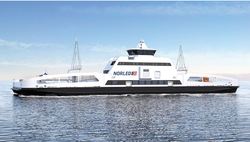Ship batteries need extra fire risk safeguards

A DNV GL report has found marine battery systems will need extra safety measures to prevent fires and explosions. Specialised fire prevention systems are already available but need to be adapted to the particular vessel and battery system used, while crews must also be taught processes for fighting battery fires specifically.
DNV GL hopes the joint development project’s findings will help guide battery safety rules as the technology evolves.
FUTURE ship battery systems will need extra safety features to prevent and control fires and explosions, a multi-country research team has found.
A report released last week by Norwegian classification group DNV GL said ventilation alone would not stop explosive gases building up if a significant part of a marine battery was on fire.
DNV GL said battery designs needed preventative features, such as current breakers, to limit the spread of fires and lessen the risk of explosive gas build-up.
The report presented findings from a project started in 2017 to better understand the technology and help make rules to govern it as battery use grows in shipping.
“It is very important that the rule development and the technology development go hand in hand,” said project manager Henrik Helgesen, a senior consultant at DNV GL.
Mr Helgesen said it was important to prevent batteries entering “thermal runaway”, in which heat creates a chemical reaction inside the battery, which creates even more heat. “The battery will vent a lot of toxic and explosive gas in addition to creating a very hot fire that will be hard to extinguish,” he said.
The systems needed to prevent such fires were already available but needed to be used in different ways depending on the vessel and the battery system, he added. Crews would need to be taught processes for fighting battery fires, which were different to those used to stop conventional diesel fires.
The research group included 16 partners, including the maritime authorities of Denmark, Norway and the US, battery makers, technology firm Kongsberg Maritime and shipowners Stena and Scandlines. These partners helped fund the project alongside the Research Council of Norway.
“We have had competitors talking openly to each other, addressing quite serious problems,” Mr Helgesen said. “To have such open communication between all the participants has been quite unique and has really strengthened the quality of the report.”
Danish Maritime Authority senior ship surveyor Denis Cederholm-Larsen said the battery industry was developing rapidly. He said good rules had to be made to ensure the technology evolved safely without restricting its potential.
Battery cell costs fell from $1,176 per kilowatt-hour to $176 from 2010 to 2018, according to DNV GL. Researchers said most vessels would use the technology to optimise their power use, but battery systems for propulsion were also being developed.